sensor VOLVO V60 CROSS COUNTRY 2016 Owner´s Manual
[x] Cancel search | Manufacturer: VOLVO, Model Year: 2016, Model line: V60 CROSS COUNTRY, Model: VOLVO V60 CROSS COUNTRY 2016Pages: 402, PDF Size: 10.32 MB
Page 4 of 402
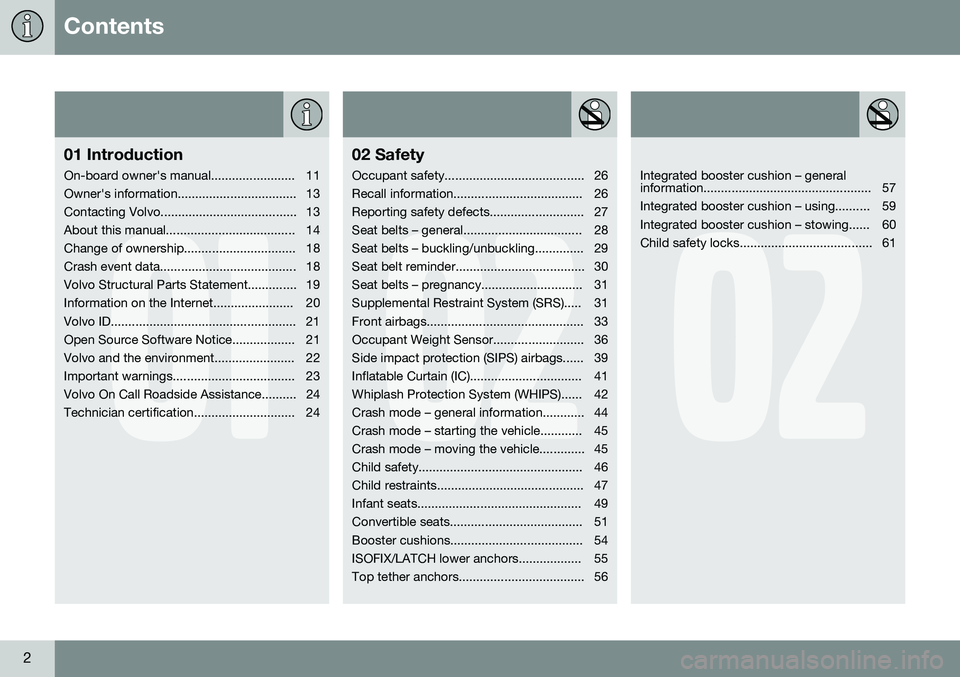
Contents
2
01
01 Introduction
On-board owner's manual........................ 11
Owner's information.................................. 13
Contacting Volvo....................................... 13
About this manual..................................... 14
Change of ownership................................ 18
Crash event data....................................... 18
Volvo Structural Parts Statement.............. 19
Information on the Internet....................... 20
Volvo ID..................................................... 21
Open Source Software Notice.................. 21
Volvo and the environment....................... 22
Important warnings................................... 23
Volvo On Call Roadside Assistance.......... 24
Technician certification............................. 24
02
02 Safety
Occupant safety........................................ 26
Recall information..................................... 26
Reporting safety defects........................... 27
Seat belts – general.................................. 28
Seat belts – buckling/unbuckling.............. 29
Seat belt reminder..................................... 30
Seat belts – pregnancy............................. 31
Supplemental Restraint System (SRS)..... 31
Front airbags............................................. 33
Occupant Weight Sensor.......................... 36
Side impact protection (SIPS) airbags...... 39
Inflatable Curtain (IC)................................ 41
Whiplash Protection System (WHIPS)...... 42
Crash mode – general information............ 44
Crash mode – starting the vehicle............ 45
Crash mode – moving the vehicle............. 45
Child safety............................................... 46
Child restraints.......................................... 47
Infant seats............................................... 49
Convertible seats...................................... 51
Booster cushions...................................... 54
ISOFIX/LATCH lower anchors.................. 55
Top tether anchors.................................... 56
02
Integrated booster cushion – general
information................................................ 57
Integrated booster cushion – using.......... 59
Integrated booster cushion – stowing...... 60
Child safety locks...................................... 61
Page 5 of 402
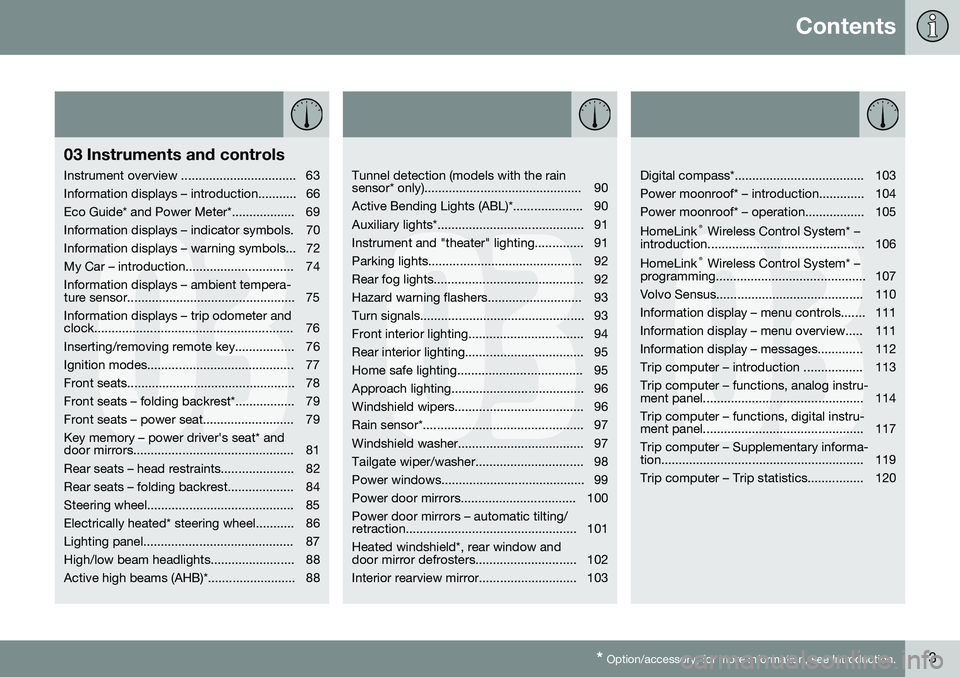
Contents
* Option/accessory, for more information, see Introduction.3
03
03 Instruments and controls
Instrument overview ................................. 63
Information displays – introduction........... 66
Eco Guide* and Power Meter*.................. 69
Information displays – indicator symbols. 70
Information displays – warning symbols... 72
My Car – introduction............................... 74Information displays – ambient tempera-
ture sensor................................................ 75 Information displays – trip odometer and
clock......................................................... 76
Inserting/removing remote key................. 76
Ignition modes.......................................... 77
Front seats................................................ 78
Front seats – folding backrest*................. 79
Front seats – power seat.......................... 79Key memory – power driver's seat* and
door mirrors.............................................. 81
Rear seats – head restraints..................... 82
Rear seats – folding backrest................... 84
Steering wheel.......................................... 85
Electrically heated* steering wheel........... 86
Lighting panel........................................... 87
High/low beam headlights........................ 88
Active high beams (AHB)*......................... 88
03
Tunnel detection (models with the rain
sensor* only)............................................. 90
Active Bending Lights (ABL)*.................... 90
Auxiliary lights*.......................................... 91
Instrument and "theater" lighting.............. 91
Parking lights............................................ 92
Rear fog lights........................................... 92
Hazard warning flashers........................... 93
Turn signals............................................... 93
Front interior lighting................................. 94
Rear interior lighting.................................. 95
Home safe lighting.................................... 95
Approach lighting...................................... 96
Windshield wipers..................................... 96
Rain sensor*.............................................. 97
Windshield washer.................................... 97
Tailgate wiper/washer............................... 98
Power windows......................................... 99
Power door mirrors................................. 100Power door mirrors – automatic tilting/
retraction................................................. 101 Heated windshield*, rear window and
door mirror defrosters............................. 102
Interior rearview mirror............................ 103
03
Digital compass*..................................... 103
Power moonroof* – introduction............. 104
Power moonroof* – operation................. 105 HomeLink ®
Wireless Control System* –
introduction............................................. 106HomeLink ®
Wireless Control System* –
programming........................................... 107
Volvo Sensus.......................................... 110
Information display – menu controls....... 111
Information display – menu overview..... 111
Information display – messages............. 112
Trip computer – introduction ................. 113Trip computer – functions, analog instru-
ment panel.............................................. 114 Trip computer – functions, digital instru-
ment panel.............................................. 117 Trip computer – Supplementary informa-
tion.......................................................... 119
Trip computer – Trip statistics................ 120
Page 6 of 402

Contents
4* Option/accessory, for more information, see Introduction.
04
04 Climate
Climate – general information................. 122
Climate – sensors................................... 122
Air quality................................................ 123
Interior Air Quality System (IAQS)*.......... 123
Climate – menu settings......................... 124
Air distribution – general......................... 124
Electronic climate control (ECC)............. 126
Heated seats........................................... 127
Temperature and blower control............ 128
Automatic climate control....................... 128
Air conditioning....................................... 129Max. defroster and electrically heated
windshield*.............................................. 129
Air distribution – function........................ 130
Air distribution – recirculation................. 131
Air distribution – table............................. 132
05
05 Loading and storage
Storage spaces....................................... 135
Tunnel console........................................ 137
Tunnel console – 12-volt sockets........... 137
Glove compartment................................ 138
Vanity mirror............................................ 138
12-volt socket in the cargo area*............ 138
Loading – general................................... 139
Loading – roof load carriers.................... 139
Load anchoring eyelets........................... 140
Grocery bag holder................................. 141
Cargo net – general information............. 141
Cargo area cover.................................... 143
Steel cargo grid....................................... 143
06
06 Locks and alarm
Remote key and key blade..................... 146
Remote key – loss................................... 146
Key memory............................................ 147
Locking/unlocking confirmation.............. 147
Immobilizer (start inhibitor)...................... 148
Remote key – functions.......................... 149
Remote key – range................................ 150Detachable key blade – general informa-
tion.......................................................... 151 Detachable key blade – detaching/rein-
serting..................................................... 151
Detachable key blade – unlocking.......... 152
Private locking........................................ 152
Remote key – replacing the battery........ 153
Keyless drive*– locking/unlocking.......... 155Keyless drive* – unlocking with key
blade....................................................... 156
Keyless drive* – key memory.................. 156
Keyless drive* – messages..................... 157
Keyless drive* – antenna locations......... 158
Locking/unlocking – from the outside..... 159
Manual locking........................................ 160
Locking/unlocking – from inside............. 160
Locking/unlocking – glove compartment 162
Page 7 of 402

Contents
* Option/accessory, for more information, see Introduction.5
06
Locking/unlocking – tailgate................... 162
Alarm – general information.................... 164
Alarm indicator........................................ 165
Alarm – arming/disarming....................... 165
Alarm signal............................................ 166
Alarm – turning off................................... 166
Alarm-related functions........................... 166
07
07 Driver support
Active chassis* (Four C).......................... 169
Stability system – introduction................ 169
Stability system – operation.................... 170Stability system – symbols and mes-
sages....................................................... 172
Adjustable steering force*....................... 174 Road Sign Information (RSI)* – introduc-
tion.......................................................... 174
Road Sign Information (RSI) – operation 175
Road Sign Information (RSI) – limitations 175
Cruise control (CC) – introduction.......... 176Cruise control (CC) – engaging and set-
ting speed............................................... 176 Toggling between ACC and CC (stand-
ard Cruise Control).................................. 178
Cruise control (CC) – deactivating.......... 178
Adaptive Cruise Control – introduction... 179
Adaptive Cruise Control – function......... 180
Adaptive Cruise Control – engaging....... 182
Adaptive Cruise Control – setting speed 183Adaptive Cruise Control – setting time
interval..................................................... 184
Adaptive Cruise Control – deactivating.. 184Adaptive Cruise Control – passing
another vehicle........................................ 186
07
Adaptive Cruise Control (ACC) – Queue
Assist...................................................... 186
Radar sensor........................................... 188
Adaptive Cruise Control – limitations...... 188Adaptive Cruise Control – symbols and
messages................................................ 190 Adaptive Cruise Control – troubleshoot-
ing........................................................... 192
Distance Alert – introduction................... 193
Distance Alert – operation....................... 193
Distance Alert – limitations...................... 194
Distance Alert – symbols and messages 196
City Safety – introduction........................ 197
City Safety – function.............................. 198
City Safety – operation............................ 199
City Safety – limitations.......................... 199
City Safety – troubleshooting.................. 200
City Safety – symbols and messages..... 202
City Safety – Laser sensor...................... 203
Collision warning – introduction.............. 204
Collision warning* – function................... 206
Collision warning* – operation................ 207
Collision warning* – Cyclist detection..... 208Collision warning* – Pedestrian detec-
tion.......................................................... 209
Page 21 of 402

01 Introduction
01
}}
19
Volvo will not contribute to spreading the above-mentioned information to third partieswithout the consent of the vehicle’s owner.However, due to national legal requirementsand regulations, Volvo may be compelled toprovide information of this type to authoritiessuch as law enforcement agencies or otherswho may assert a legal right to obtain suchinformation. Volvo and service and repair facilities with agreements with Volvo have access to thespecial technical equipment required in orderto read and interpret the information storedby the vehicle’s computers. Volvo is responsi-ble for ensuring that the information transmit-ted to Volvo during service and maintenanceis stored and handled in a secure manner andthat this handling is done in accordance withapplicable legal requirements. For additionalinformation, contact: For additional information, contact: In the United States Volvo Cars of North America, LLC Customer Care Center1 Volvo Drive, P.O. box 914Rockleigh, New Jersey 076471-800-458-1552www.volvocars.com/us In Canada
Volvo Cars of Canada National Customer Service9130 Leslie StreetRichmond Hill, Ontario L4B 0B91-800-663-8255www.volvocars.com/ca
Related information
•
Information on the Internet (p. 20)
• Contacting Volvo (p. 13)
Volvo Structural Parts Statement
Volvo has always been and continues to be a leader in automotive safety. Volvo engineers and manufactures vehicles designed to help protect vehicle occupants inthe event of a collision. Volvos are designed to absorb the impact of a collision. This energy absorption systemincluding, but not limited to, structural com-ponents such as bumper reinforcement bars,bumper energy absorbers, frames, rails,fender aprons, A-pillars, B-pillars and bodypanels must work together to maintain cabinintegrity and protect the vehicle occupants. The supplemental restraint system including but not limited to air bags, side curtain airbags, and deployment sensors work togetherwith the above components to provide propertiming for air bag deployment. Due to the above, Volvo Cars of North Amer- ica does not support the use of aftermarket,alternative or anything other than originalVolvo parts for collision repair. In addition Volvo does not support the use or re-use of structural components from anexisting vehicle that has been previouslydamaged. Although these parts may appearequivalent, it is difficult to tell if the parts havebeen previously replaced with non-OE partsor if the part has been damaged as a result ofa prior collision. The quality of these used
Page 24 of 402
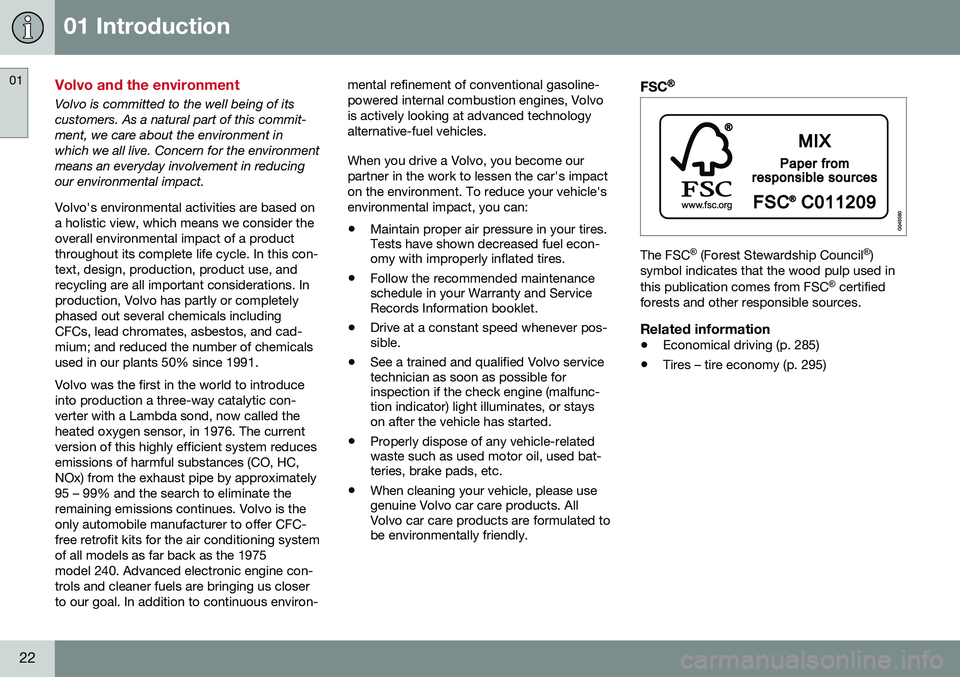
01 Introduction
01
22
Volvo and the environment
Volvo is committed to the well being of its customers. As a natural part of this commit-ment, we care about the environment inwhich we all live. Concern for the environmentmeans an everyday involvement in reducingour environmental impact. Volvo's environmental activities are based on a holistic view, which means we consider theoverall environmental impact of a productthroughout its complete life cycle. In this con-text, design, production, product use, andrecycling are all important considerations. Inproduction, Volvo has partly or completelyphased out several chemicals includingCFCs, lead chromates, asbestos, and cad-mium; and reduced the number of chemicalsused in our plants 50% since 1991. Volvo was the first in the world to introduce into production a three-way catalytic con-verter with a Lambda sond, now called theheated oxygen sensor, in 1976. The currentversion of this highly efficient system reducesemissions of harmful substances (CO, HC,NOx) from the exhaust pipe by approximately95 – 99% and the search to eliminate theremaining emissions continues. Volvo is theonly automobile manufacturer to offer CFC-free retrofit kits for the air conditioning systemof all models as far back as the 1975model 240. Advanced electronic engine con-trols and cleaner fuels are bringing us closerto our goal. In addition to continuous environ-mental refinement of conventional gasoline-powered internal combustion engines, Volvois actively looking at advanced technologyalternative-fuel vehicles. When you drive a Volvo, you become our partner in the work to lessen the car's impacton the environment. To reduce your vehicle'senvironmental impact, you can: •
Maintain proper air pressure in your tires. Tests have shown decreased fuel econ-omy with improperly inflated tires.
• Follow the recommended maintenanceschedule in your Warranty and ServiceRecords Information booklet.
• Drive at a constant speed whenever pos-sible.
• See a trained and qualified Volvo servicetechnician as soon as possible forinspection if the check engine (malfunc-tion indicator) light illuminates, or stayson after the vehicle has started.
• Properly dispose of any vehicle-relatedwaste such as used motor oil, used bat-teries, brake pads, etc.
• When cleaning your vehicle, please usegenuine Volvo car care products. AllVolvo car care products are formulated tobe environmentally friendly.
FSC®
The FSC ®
(Forest Stewardship Council ®
)
symbol indicates that the wood pulp used in this publication comes from FSC ®
certified
forests and other responsible sources.
Related information
• Economical driving (p. 285)
• Tires – tire economy (p. 295)
Page 34 of 402
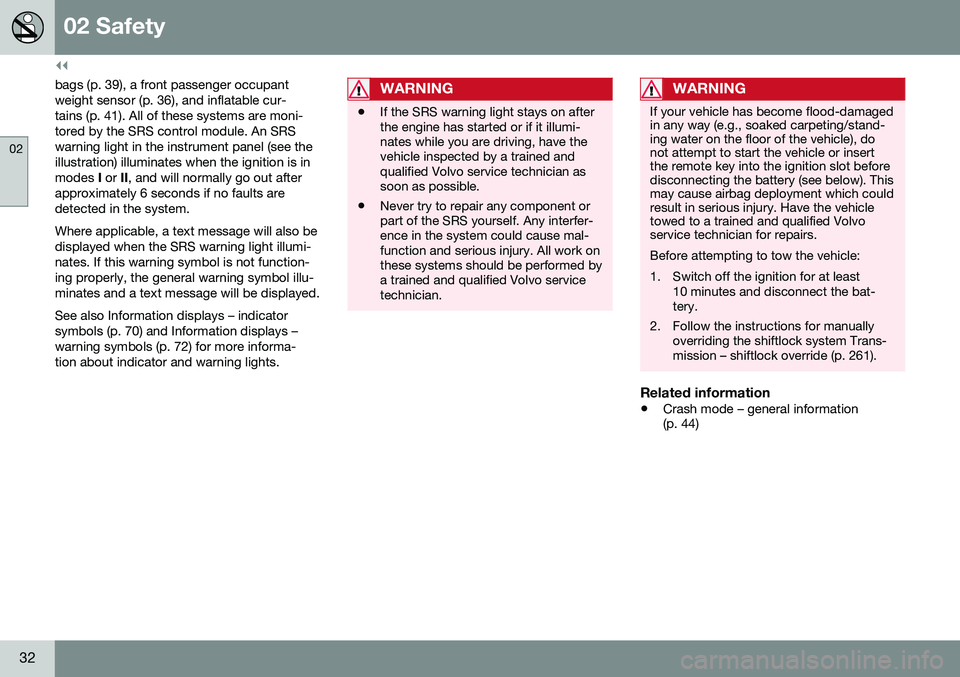
||
02 Safety
02
32
bags (p. 39), a front passenger occupant weight sensor (p. 36), and inflatable cur-tains (p. 41). All of these systems are moni-tored by the SRS control module. An SRSwarning light in the instrument panel (see theillustration) illuminates when the ignition is inmodes I or II, and will normally go out after
approximately 6 seconds if no faults aredetected in the system. Where applicable, a text message will also be displayed when the SRS warning light illumi-nates. If this warning symbol is not function-ing properly, the general warning symbol illu-minates and a text message will be displayed. See also Information displays – indicator symbols (p. 70) and Information displays –warning symbols (p. 72) for more informa-tion about indicator and warning lights.WARNING
• If the SRS warning light stays on after the engine has started or if it illumi-nates while you are driving, have thevehicle inspected by a trained andqualified Volvo service technician assoon as possible.
• Never try to repair any component orpart of the SRS yourself. Any interfer-ence in the system could cause mal-function and serious injury. All work onthese systems should be performed bya trained and qualified Volvo servicetechnician.
WARNING
If your vehicle has become flood-damaged in any way (e.g., soaked carpeting/stand-ing water on the floor of the vehicle), donot attempt to start the vehicle or insertthe remote key into the ignition slot beforedisconnecting the battery (see below). Thismay cause airbag deployment which couldresult in serious injury. Have the vehicletowed to a trained and qualified Volvoservice technician for repairs. Before attempting to tow the vehicle:
1. Switch off the ignition for at least
10 minutes and disconnect the bat- tery.
2. Follow the instructions for manually overriding the shiftlock system Trans-mission – shiftlock override (p. 261).
Related information
• Crash mode – general information (p. 44)
Page 35 of 402

02 Safety
02
}}
33
Front airbags
The front airbags supplement the three-point seat belts (p. 28). For these airbags to providethe protection intended, seat belts must beworn at all times.
G018665
The front airbag systemThe front airbag system includes gas genera- tors surrounded by the airbags, and decelera-tion sensors that activate the gas generators,causing the airbags to be inflated with nitro-gen gas.
Location of the passenger's side front airbagAs the movement of the seats' occupants compresses the airbags, some of the gas isexpelled at a controlled rate to provide bettercushioning. Both seat belt pretensioners alsodeploy, minimizing seat belt slack. The entireprocess, including inflation and deflation ofthe airbags, takes approximately one fifth of asecond. The location of the front airbags is indicated by SRS AIRBAG embossed on the steering
wheel pad and above the glove compartment,and by decals on both sun visors and on thefront and far right side of the dash. The driver's side front airbag is folded and located in the steering wheel hub. The passenger's side front airbag is folded behind a panel located above the glove com-partment.
WARNING
• The airbags in the vehicle are designed to be a SUPPLEMENT to–not areplacement for–the three-point seatbelts. For maximum protection, wearseat belts at all times. Be aware thatno system can prevent all possibleinjuries that may occur in an accident.
• Never drive with your hands on thesteering wheel pad/airbag housing.
• The front airbags are designed to helpprevent serious injury. Deploymentoccurs very quickly and with consider-able force. During normal deploymentand depending on variables such asseating position, one may experienceabrasions, bruises, swellings, or otherinjuries as a result from deployment ofone or both of the airbags.
• When installing any accessory equip-ment, make sure that the front airbagsystem is not damaged. Any interfer-ence in the system could cause mal-function.
Front airbag deployment
•
The front airbags are designed to deploy during certain frontal or front-angular col-lisions, impacts, or decelerations,depending on the crash severity, angle,speed and object impacted. The airbagsmay also deploy in certain non-frontal
Page 36 of 402
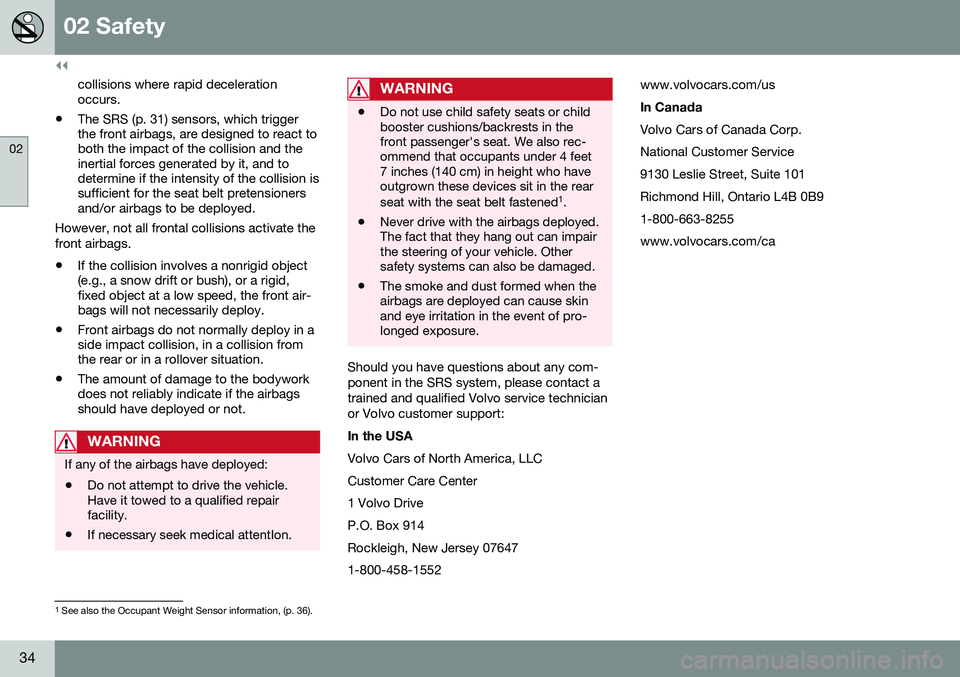
||
02 Safety
02
34
collisions where rapid deceleration occurs.
• The SRS (p. 31) sensors, which triggerthe front airbags, are designed to react toboth the impact of the collision and theinertial forces generated by it, and todetermine if the intensity of the collision issufficient for the seat belt pretensionersand/or airbags to be deployed.
However, not all frontal collisions activate the front airbags.
• If the collision involves a nonrigid object (e.g., a snow drift or bush), or a rigid,fixed object at a low speed, the front air-bags will not necessarily deploy.
• Front airbags do not normally deploy in aside impact collision, in a collision fromthe rear or in a rollover situation.
• The amount of damage to the bodyworkdoes not reliably indicate if the airbagsshould have deployed or not.
WARNING
If any of the airbags have deployed:
• Do not attempt to drive the vehicle. Have it towed to a qualified repairfacility.
• If necessary seek medical attentIon.
WARNING
•Do not use child safety seats or child booster cushions/backrests in thefront passenger's seat. We also rec-ommend that occupants under 4 feet7 inches (140 cm) in height who haveoutgrown these devices sit in the rear seat with the seat belt fastened 1
.
• Never drive with the airbags deployed. The fact that they hang out can impairthe steering of your vehicle. Othersafety systems can also be damaged.
• The smoke and dust formed when theairbags are deployed can cause skinand eye irritation in the event of pro-longed exposure.
Should you have questions about any com- ponent in the SRS system, please contact atrained and qualified Volvo service technicianor Volvo customer support: In the USA Volvo Cars of North America, LLC Customer Care Center1 Volvo DriveP.O. Box 914Rockleigh, New Jersey 076471-800-458-1552 www.volvocars.com/us In Canada Volvo Cars of Canada Corp. National Customer Service9130 Leslie Street, Suite 101Richmond Hill, Ontario L4B 0B91-800-663-8255www.volvocars.com/ca
1
See also the Occupant Weight Sensor information, (p. 36).
Page 38 of 402
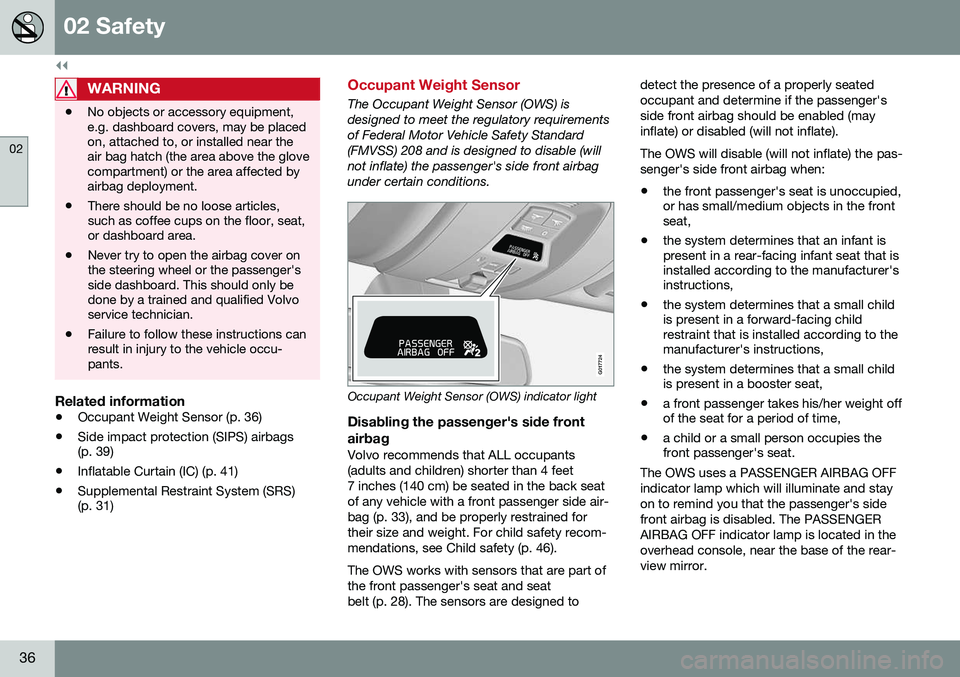
||
02 Safety
02
36
WARNING
•No objects or accessory equipment, e.g. dashboard covers, may be placedon, attached to, or installed near theair bag hatch (the area above the glovecompartment) or the area affected byairbag deployment.
• There should be no loose articles,such as coffee cups on the floor, seat,or dashboard area.
• Never try to open the airbag cover onthe steering wheel or the passenger'sside dashboard. This should only bedone by a trained and qualified Volvoservice technician.
• Failure to follow these instructions canresult in injury to the vehicle occu-pants.
Related information
•
Occupant Weight Sensor (p. 36)
• Side impact protection (SIPS) airbags (p. 39)
• Inflatable Curtain (IC) (p. 41)
• Supplemental Restraint System (SRS)(p. 31)
Occupant Weight Sensor
The Occupant Weight Sensor (OWS) is designed to meet the regulatory requirementsof Federal Motor Vehicle Safety Standard(FMVSS) 208 and is designed to disable (willnot inflate) the passenger's side front airbagunder certain conditions.
2
2
G017724
Occupant Weight Sensor (OWS) indicator light
Disabling the passenger's side front
airbag
Volvo recommends that ALL occupants (adults and children) shorter than 4 feet7 inches (140 cm) be seated in the back seatof any vehicle with a front passenger side air-bag (p. 33), and be properly restrained fortheir size and weight. For child safety recom-mendations, see Child safety (p. 46). The OWS works with sensors that are part of the front passenger's seat and seatbelt (p. 28). The sensors are designed to detect the presence of a properly seatedoccupant and determine if the passenger'sside front airbag should be enabled (mayinflate) or disabled (will not inflate). The OWS will disable (will not inflate) the pas- senger's side front airbag when:
• the front passenger's seat is unoccupied, or has small/medium objects in the frontseat,
• the system determines that an infant ispresent in a rear-facing infant seat that isinstalled according to the manufacturer'sinstructions,
• the system determines that a small childis present in a forward-facing childrestraint that is installed according to themanufacturer's instructions,
• the system determines that a small childis present in a booster seat,
• a front passenger takes his/her weight offof the seat for a period of time,
• a child or a small person occupies thefront passenger's seat.
The OWS uses a PASSENGER AIRBAG OFF indicator lamp which will illuminate and stayon to remind you that the passenger's sidefront airbag is disabled. The PASSENGERAIRBAG OFF indicator lamp is located in theoverhead console, near the base of the rear-view mirror.